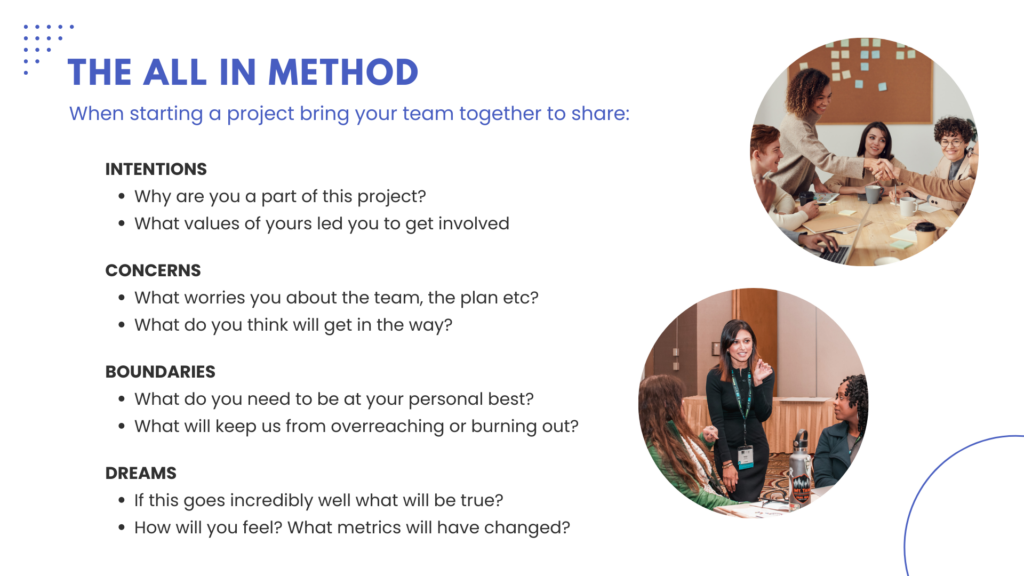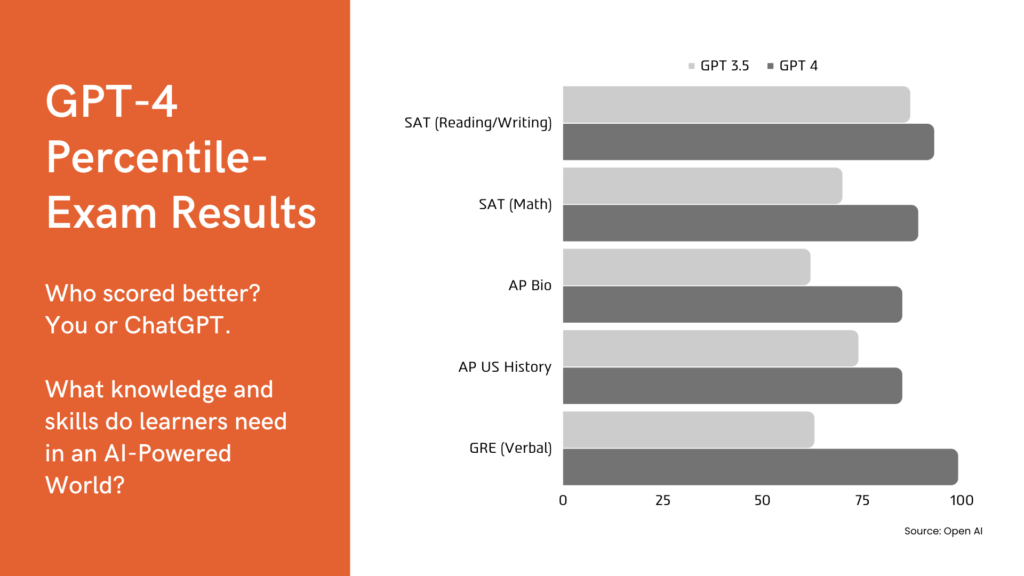In a rapidly changing world driven by AI, educators, and schools face the challenge of redefining their identities and embracing innovation. James Clear, in his book “Atomic Habits,” emphasizes the importance of identity-based habits over outcomes. By focusing on who we want to become, we foster meaningful and lasting change. For schools and educators, this means shifting from chasing metrics to nurturing empathetic and innovative cultures that prepare students for the future.
Amidst this transformation, some are curious, while others are skeptical – disillusioned by the promise of technology. However, the present moment stands out due to the convergence of two serendipitous events that provide a unique opportunity for growth and change. The collision of these moments paves the way for a redefined future shaped by AI and the collective efforts of our schools and communities.
TL;DR
When you bring people together to talk about their fears, their challenges, and also their hopes and dreams you create cultures of innovation that begin with empathy. If you want to turn your curiosity into confidence I invite you to join, “The AI Bootcamp,” a 4-week immersive experience where you develop the AI literacy skills to enhance productivity, boost creativity, and lead your organization into the future.
AI Roundtables in Schools: Fostering Cultures of Innovation and Empathy
Serendipitous Moment #1: AI’s Cross-Generational Impact
Picture this: for the first time in history, every generation is witnessing the same monumental shift in how we work and learn, propelled by the remarkable advances in artificial intelligence. This presents a unique opportunity for schools to unite communities in designing schools. By hosting AI Roundtables, schools can facilitate meaningful conversations that foster empathy and drive innovation.
By designing schools that not only equip individuals with the knowledge and skills to excel in their careers but also empower them to become thriving citizens in this rapidly changing world, we can create cultures of innovation that begin with empathy. Now, more than ever, our humanity, ethics, and empathy for one another are essential.
If we remain fixated on standardized test scores, letter grades, and school rankings, we’ll perpetuate existing inequalities and miss the opportunity to ask, “Who do we need to be in a world powered by AI technology?”
Here’s an example:
Consider the last significant technological shift we experienced in 2007 with the release of the iPhone. It redefined mobile technology and changed how we interact with our world, much like ChatGPT today. However, the iPhone came with a hefty price tag, limiting its accessibility. Unlike many emerging technologies, ChatGPT arrived as an uninvited guest and sat down at the dinner table, and made themselves at home. Today’s AI revolution, however, leaves us with little choice. We’ll soon see generative AI capabilities integrated into nearly every tool we use, impacting how we learn, work, and live. For instance, Microsoft’s announcement of Co-Pilot demonstrates how AI can offload tasks and free up time for more meaningful pursuits. Watch the trailer below to see the potential of AI in action.
As a former Education Leadership Executive at Apple, I witnessed firsthand how people grappled with change and the integration of new technologies into their existing structures. But ultimately, the decision to adopt and integrate was yours to make.
- Parents may wonder, “What implications does AI have for my child’s future?”
- Teachers may ask themselves, “How can AI be used to enhance student assessment?”
- Students may question, “Is my education preparing me for a future shaped by AI?”
This is why schools should host AI roundtables – to bring communities together and discuss the impact of AI on our lives, fostering cultures of empathy-driven innovation in the process.
When it comes to AI, everyone has questions. No one has answers. Herein lies the opportunity.
Serendipitous Moment #2: Collective Curiosity – Who Do We Want to Be?
In his best-selling book “Atomic Habits,” James Clear highlights the significance of focusing on identity over outcomes. He shares, “A similar pattern exists whether we are discussing individuals, organizations, or societies. There are a set of beliefs and assumptions that shape the system, an identity behind the habits.”
As we venture into an AI-driven world, we find ourselves in the midst of a collective identity crisis – and surprisingly, that’s a good thing. This pivotal moment prompts us to question who we want to be in a world where AI continues to reshape our lives and redefine our roles.
This moment of collective curiosity about our future presents a unique opportunity for schools, organizations, and communities to come together and design what’s next. Although various future-ready initiatives have accelerated the adoption of 1:1 technology and defined the ideal graduate profile, we must admit that we have largely fallen short of creating agile cultures where adults have the autonomy to turn ideas into impact.
The pressure to maintain an outdated, Industrial Age model of schooling that no longer serves today’s adults or young people weighs heavily on those with the least amount of agency and autonomy to implement necessary changes. Our collective inability to let go of obsolete assessment practices, break away from content taught in silos, and relinquish other Industrial Age practices has led to a society where children face increasing stress and anxiety, while educators and administrators feel burned out and overwhelmed.
What does it mean to be human?
Organizations like the World Economic Forum and UNESCO, as well as schools advocating for equipping today’s learners with future-ready skills and mindsets, have struggled to help people understand the implications of AI in education. However, ChatGPT has demonstrated the potential of AI by swiftly passing one standardized test after another, prompting everyone to wonder: In a world powered by AI, what does it mean to be human? What knowledge and skills do we need to cultivate to thrive in this new landscape?
Hosting an AI roundtable at your school or organization can help bridge the gap between our current reality and the agile, innovative cultures we need to create. By embracing this identity crisis and fostering open discussions, we can redefine what it means to be human in the age of AI and reimagine education for the better.
The Future is Now: Hosting an AI Roundtable
Last week, Stefan Bauschard, author of ChatGPT: A Book by Educators, and I hosted a webinar with over 250 people. When we asked them about ChatGPT, the unanimous response was curiosity. There’s so much we can achieve when we step back and truly listen to one another. As we discuss change initiatives, we often hear people say, “If only this group did X, then everything would work out great.”
The reality, however, is that everyone faces roadblocks. Our job is to uncover these obstacles and solve them together. It’s why I believe cultures of innovation begin with a culture of empathy.
When we approach challenges with empathy, our preconceptions are challenged by what we learn. Once we identify the roadblocks, we can design effective solutions that allow us to turn our ideas into impact.
In this moment of curiosity and caution, I encourage you to consider hosting an AI Roundtable with your team, organization, and community. Gather individuals to discuss and design what’s next. All too often, conversations like these are open-ended and dominated by a few voices, leaving no roadmap for turning ideas into impact. At Designing Schools, we use design thinking frameworks to scaffold conversations, ensuring everyone has a voice, that ideas turn into impact, and participants leave feeling optimistic rather than overwhelmed about the future.
Avoid the common pitfall of designing change for people rather than with them.
When we begin by asking people to share their challenges, hopes, and dreams, we build trust and create a shared vision for the future. A culture of trust motivates everyone to take ownership of their role, enabling organizations to generate better ideas and scale them to create impact. Ultimately, we can realize our true identity by moving away from what we want and towards who we want to be.
Instead of sharing an endless list of strategies, I’ll share the best one called “Intentions, Concerns, Boundaries, and Dreams. It’s a framework created by authors Bob Gower and Alex Jamieson who wrote, “Radical Alignment: How to Have Game-Changing Conversations That Transform Your Business and Life.

It’s one of the strategies we’re teaching in our new course, “The AI Bootcamp: From Curious to Confident in the Age of AI Even If You’re Short on Time.” Doors are now open for enrollment and you can join a community of individuals who are learning and leading their organizations into the future.

I’m Sabba.
I believe that the future should be designed. Not left to chance.
Over the past decade, using design thinking practices I've helped schools and businesses create a culture of innovation where everyone is empowered to move from idea to impact, to address complex challenges and discover opportunities.
stay connected
designing schools
